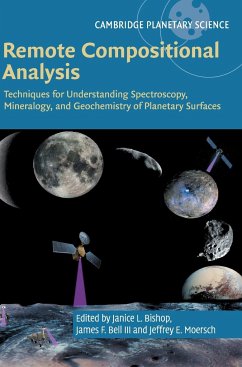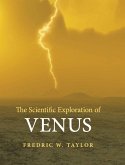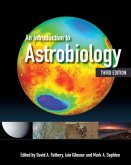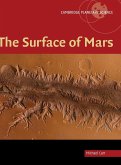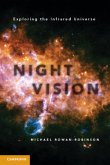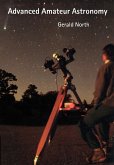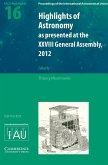Remote Compositional Analysis
Herausgeber: Bishop, Janice L.; Moersch, Jeffrey E.; Bell III, James F.
Remote Compositional Analysis
Herausgeber: Bishop, Janice L.; Moersch, Jeffrey E.; Bell III, James F.
- Gebundenes Buch
- Merkliste
- Auf die Merkliste
- Bewerten Bewerten
- Teilen
- Produkt teilen
- Produkterinnerung
- Produkterinnerung
Comprehensive overview of the spectroscopic, mineralogical, and geochemical techniques used in planetary remote sensing.
Andere Kunden interessierten sich auch für
![Staged Plasma Gas Compression Guns with Emphasis on Electron Plasma Modes for Facilitating Nuclear Fueling of Remote Relativistic Spacecraft. Staged Plasma Gas Compression Guns with Emphasis on Electron Plasma Modes for Facilitating Nuclear Fueling of Remote Relativistic Spacecraft.]() James M. EssigStaged Plasma Gas Compression Guns with Emphasis on Electron Plasma Modes for Facilitating Nuclear Fueling of Remote Relativistic Spacecraft.18,99 €
James M. EssigStaged Plasma Gas Compression Guns with Emphasis on Electron Plasma Modes for Facilitating Nuclear Fueling of Remote Relativistic Spacecraft.18,99 €![The Scientific Exploration of Venus The Scientific Exploration of Venus]() Fredric W. TaylorThe Scientific Exploration of Venus87,99 €
Fredric W. TaylorThe Scientific Exploration of Venus87,99 €![An Introduction to Astrobiology An Introduction to Astrobiology]() An Introduction to Astrobiology47,99 €
An Introduction to Astrobiology47,99 €![The Surface of Mars The Surface of Mars]() Michael H. CarrThe Surface of Mars204,99 €
Michael H. CarrThe Surface of Mars204,99 €![Night Vision Night Vision]() Michael Rowan-RobinsonNight Vision53,99 €
Michael Rowan-RobinsonNight Vision53,99 €![Advanced Amateur Astronomy Advanced Amateur Astronomy]() Gerald NorthAdvanced Amateur Astronomy68,99 €
Gerald NorthAdvanced Amateur Astronomy68,99 €![Highlights of Astronomy Highlights of Astronomy]() Highlights of Astronomy95,99 €
Highlights of Astronomy95,99 €-
-
-
Comprehensive overview of the spectroscopic, mineralogical, and geochemical techniques used in planetary remote sensing.
Produktdetails
- Produktdetails
- Verlag: Cambridge University Press
- Seitenzahl: 656
- Erscheinungstermin: 28. November 2019
- Englisch
- Abmessung: 250mm x 175mm x 39mm
- Gewicht: 1293g
- ISBN-13: 9781107186200
- ISBN-10: 110718620X
- Artikelnr.: 55314740
- Herstellerkennzeichnung
- Libri GmbH
- Europaallee 1
- 36244 Bad Hersfeld
- gpsr@libri.de
- Verlag: Cambridge University Press
- Seitenzahl: 656
- Erscheinungstermin: 28. November 2019
- Englisch
- Abmessung: 250mm x 175mm x 39mm
- Gewicht: 1293g
- ISBN-13: 9781107186200
- ISBN-10: 110718620X
- Artikelnr.: 55314740
- Herstellerkennzeichnung
- Libri GmbH
- Europaallee 1
- 36244 Bad Hersfeld
- gpsr@libri.de
Part I. Theory of Remote Compositional Analysis Techniques and Laboratory
Measurements: 1. Electronic spectra of minerals in the visible and
near-infrared regions; 2. Theory of reflectance and emittance spectroscopy
of geologic materials in the visible and infrared regions; 3. Mid-IR
(thermal) emission and reflectance spectroscopy: laboratory spectra of
geologic materials; 4. Visible and near-infrared reflectance spectroscopy:
laboratory spectra of geologic materials; 5. Visible and infrared
spectroscopy of ices, volatiles and organics; 6. Raman spectroscopy: theory
and laboratory spectra of geologic materials; 7. Mössbauer spectroscopy:
theory and laboratory spectra of geologic materials; 8. Laser-induced
breakdown spectroscopy: theory and laboratory spectra of geologic
materials; 9. Fundamentals of neutron, X-ray and gamma ray spectroscopy;
10. Radar remote sensing: theory and applications; Part II. Terrestrial
Field and Airborne Applications: 11. Visible and near-infrared reflectance
spectroscopy: field and airborne measurements; 12. Raman spectroscopy:
field measurements; Part III. Analysis Methods: 13. Effects of
environmental conditions on spectral measurements; 14. Hyper- and
multispectral VNIR imaging analysis; 15. Thermal infrared spectral
modeling; 16. Geochemical interpretations using multiple remote datasets;
Part IV. Applications to Planetary Surfaces: 17. Spectral analyses of
Mercury; 18. Compositional analysis of the Moon from the visible and
near-infrared; 19. Spectral analyses of asteroids; 20. VIS-NIR spectral
analyses of asteroids and comets from Dawn and Rosetta; 21. Spectral
analyses of Saturn's moons using Cassini-VIMS; 22. Spectroscopy of Pluto
and its satellites; 23. VSWIR spectral analyses of Mars from orbit using
CRISM and OMEGA; 24. Thermal infrared spectral analyses of Mars from orbit
using TES and THEMIS; 25. Rover-based thermal infrared remote sensing of
Mars using the mini-TES instrument; 26. Compositional and mineralogic
analyses of Mars using multispectral imaging on the Mars Exploration Rover,
Phoenix, and Mars Science Laboratory Missions; 27. Iron mineralogy,
oxidation state, and alteration on Mars from Mössbauer spectroscopy at
Gusev Crater and Meridiani Planum; 28. Elemental analyses of Mars using
APXS; 29. Elemental analyses of Mars with LIBS by ChemCam and SuperCam; 30.
X-ray, gamma-ray, and neutron spectroscopy: planetary missions; 31. Radar
remote sensing of planetary bodies.
Measurements: 1. Electronic spectra of minerals in the visible and
near-infrared regions; 2. Theory of reflectance and emittance spectroscopy
of geologic materials in the visible and infrared regions; 3. Mid-IR
(thermal) emission and reflectance spectroscopy: laboratory spectra of
geologic materials; 4. Visible and near-infrared reflectance spectroscopy:
laboratory spectra of geologic materials; 5. Visible and infrared
spectroscopy of ices, volatiles and organics; 6. Raman spectroscopy: theory
and laboratory spectra of geologic materials; 7. Mössbauer spectroscopy:
theory and laboratory spectra of geologic materials; 8. Laser-induced
breakdown spectroscopy: theory and laboratory spectra of geologic
materials; 9. Fundamentals of neutron, X-ray and gamma ray spectroscopy;
10. Radar remote sensing: theory and applications; Part II. Terrestrial
Field and Airborne Applications: 11. Visible and near-infrared reflectance
spectroscopy: field and airborne measurements; 12. Raman spectroscopy:
field measurements; Part III. Analysis Methods: 13. Effects of
environmental conditions on spectral measurements; 14. Hyper- and
multispectral VNIR imaging analysis; 15. Thermal infrared spectral
modeling; 16. Geochemical interpretations using multiple remote datasets;
Part IV. Applications to Planetary Surfaces: 17. Spectral analyses of
Mercury; 18. Compositional analysis of the Moon from the visible and
near-infrared; 19. Spectral analyses of asteroids; 20. VIS-NIR spectral
analyses of asteroids and comets from Dawn and Rosetta; 21. Spectral
analyses of Saturn's moons using Cassini-VIMS; 22. Spectroscopy of Pluto
and its satellites; 23. VSWIR spectral analyses of Mars from orbit using
CRISM and OMEGA; 24. Thermal infrared spectral analyses of Mars from orbit
using TES and THEMIS; 25. Rover-based thermal infrared remote sensing of
Mars using the mini-TES instrument; 26. Compositional and mineralogic
analyses of Mars using multispectral imaging on the Mars Exploration Rover,
Phoenix, and Mars Science Laboratory Missions; 27. Iron mineralogy,
oxidation state, and alteration on Mars from Mössbauer spectroscopy at
Gusev Crater and Meridiani Planum; 28. Elemental analyses of Mars using
APXS; 29. Elemental analyses of Mars with LIBS by ChemCam and SuperCam; 30.
X-ray, gamma-ray, and neutron spectroscopy: planetary missions; 31. Radar
remote sensing of planetary bodies.
Part I. Theory of Remote Compositional Analysis Techniques and Laboratory
Measurements: 1. Electronic spectra of minerals in the visible and
near-infrared regions; 2. Theory of reflectance and emittance spectroscopy
of geologic materials in the visible and infrared regions; 3. Mid-IR
(thermal) emission and reflectance spectroscopy: laboratory spectra of
geologic materials; 4. Visible and near-infrared reflectance spectroscopy:
laboratory spectra of geologic materials; 5. Visible and infrared
spectroscopy of ices, volatiles and organics; 6. Raman spectroscopy: theory
and laboratory spectra of geologic materials; 7. Mössbauer spectroscopy:
theory and laboratory spectra of geologic materials; 8. Laser-induced
breakdown spectroscopy: theory and laboratory spectra of geologic
materials; 9. Fundamentals of neutron, X-ray and gamma ray spectroscopy;
10. Radar remote sensing: theory and applications; Part II. Terrestrial
Field and Airborne Applications: 11. Visible and near-infrared reflectance
spectroscopy: field and airborne measurements; 12. Raman spectroscopy:
field measurements; Part III. Analysis Methods: 13. Effects of
environmental conditions on spectral measurements; 14. Hyper- and
multispectral VNIR imaging analysis; 15. Thermal infrared spectral
modeling; 16. Geochemical interpretations using multiple remote datasets;
Part IV. Applications to Planetary Surfaces: 17. Spectral analyses of
Mercury; 18. Compositional analysis of the Moon from the visible and
near-infrared; 19. Spectral analyses of asteroids; 20. VIS-NIR spectral
analyses of asteroids and comets from Dawn and Rosetta; 21. Spectral
analyses of Saturn's moons using Cassini-VIMS; 22. Spectroscopy of Pluto
and its satellites; 23. VSWIR spectral analyses of Mars from orbit using
CRISM and OMEGA; 24. Thermal infrared spectral analyses of Mars from orbit
using TES and THEMIS; 25. Rover-based thermal infrared remote sensing of
Mars using the mini-TES instrument; 26. Compositional and mineralogic
analyses of Mars using multispectral imaging on the Mars Exploration Rover,
Phoenix, and Mars Science Laboratory Missions; 27. Iron mineralogy,
oxidation state, and alteration on Mars from Mössbauer spectroscopy at
Gusev Crater and Meridiani Planum; 28. Elemental analyses of Mars using
APXS; 29. Elemental analyses of Mars with LIBS by ChemCam and SuperCam; 30.
X-ray, gamma-ray, and neutron spectroscopy: planetary missions; 31. Radar
remote sensing of planetary bodies.
Measurements: 1. Electronic spectra of minerals in the visible and
near-infrared regions; 2. Theory of reflectance and emittance spectroscopy
of geologic materials in the visible and infrared regions; 3. Mid-IR
(thermal) emission and reflectance spectroscopy: laboratory spectra of
geologic materials; 4. Visible and near-infrared reflectance spectroscopy:
laboratory spectra of geologic materials; 5. Visible and infrared
spectroscopy of ices, volatiles and organics; 6. Raman spectroscopy: theory
and laboratory spectra of geologic materials; 7. Mössbauer spectroscopy:
theory and laboratory spectra of geologic materials; 8. Laser-induced
breakdown spectroscopy: theory and laboratory spectra of geologic
materials; 9. Fundamentals of neutron, X-ray and gamma ray spectroscopy;
10. Radar remote sensing: theory and applications; Part II. Terrestrial
Field and Airborne Applications: 11. Visible and near-infrared reflectance
spectroscopy: field and airborne measurements; 12. Raman spectroscopy:
field measurements; Part III. Analysis Methods: 13. Effects of
environmental conditions on spectral measurements; 14. Hyper- and
multispectral VNIR imaging analysis; 15. Thermal infrared spectral
modeling; 16. Geochemical interpretations using multiple remote datasets;
Part IV. Applications to Planetary Surfaces: 17. Spectral analyses of
Mercury; 18. Compositional analysis of the Moon from the visible and
near-infrared; 19. Spectral analyses of asteroids; 20. VIS-NIR spectral
analyses of asteroids and comets from Dawn and Rosetta; 21. Spectral
analyses of Saturn's moons using Cassini-VIMS; 22. Spectroscopy of Pluto
and its satellites; 23. VSWIR spectral analyses of Mars from orbit using
CRISM and OMEGA; 24. Thermal infrared spectral analyses of Mars from orbit
using TES and THEMIS; 25. Rover-based thermal infrared remote sensing of
Mars using the mini-TES instrument; 26. Compositional and mineralogic
analyses of Mars using multispectral imaging on the Mars Exploration Rover,
Phoenix, and Mars Science Laboratory Missions; 27. Iron mineralogy,
oxidation state, and alteration on Mars from Mössbauer spectroscopy at
Gusev Crater and Meridiani Planum; 28. Elemental analyses of Mars using
APXS; 29. Elemental analyses of Mars with LIBS by ChemCam and SuperCam; 30.
X-ray, gamma-ray, and neutron spectroscopy: planetary missions; 31. Radar
remote sensing of planetary bodies.

